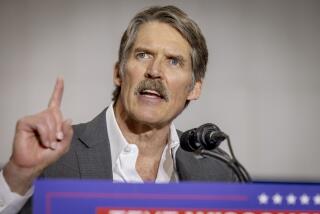THE TIMES POLL : Herschensohn Narrows Boxer’s Lead to 9 Points : Campaigns: Feinstein holds a 19-point lead over Seymour among registered voters in other Senate race.
Democratic Rep. Barbara Boxer’s once-lopsided lead over Republican Bruce Herschensohn in their U.S. Senate race has been halved to nine points among all registered voters and to just five among those likely to cast ballots, The Los Angeles Times Poll has found.
In California’s other Senate race, however, Democrat Dianne Feinstein is maintaining a lead of 19 points over Republican Sen. John Seymour among registered voters.
After paying little attention to these two contests through the summer, voters clearly are sizing up the candidates as the Nov. 3 election approaches. And as wavering voters have taken critical looks in recent weeks, Herschensohn has gained the momentum, Times Poll interviews showed.
The statewide survey indicated that many voters who were previously undecided appear to have sided with the former Los Angeles television commentator, who scored a campaign coup by running two weeks of effective TV commercials before the Marin County congresswoman went on the air with her ads.
Although Boxer has lost little support overall, Herschensohn has made substantial gains among people age 65 and older, independents, Republicans--men and women--and so-called Reagan Democrats, the poll found. He also has picked up ground in Northern California.
Boxer and Feinstein benefit from running in the Year of the Woman and in an election where the political pendulum is swinging toward the Democratic Party. A plurality of voters believe that the Democratic Party will be better than the GOP at handling California’s problems, an attitude that has increased during the last 17 months, various Times surveys have shown.
But voters are closely divided on the importance of electing a woman to the Senate and most think it is not important to elect two women, according to interviews.
Also, in the midst of a stubborn recession with hundreds of thousands of jobs lost and many more in jeopardy, Californians appear to be siding more with Republican positions than with Democrats on the issues of defense cuts and environmental regulations.
The Times Poll, directed by John Brennan, interviewed 1,110 registered voters by telephone for four days ending Friday night. Among these were 833 people considered likely to vote. The margin of error for all registered voters was three percentage points in either direction. For likely voters it was four points.
Among registered voters, Boxer led Herschensohn by 50% to 41%, with 1% for other candidates and 8% undecided. In a mid-September Times survey, Boxer enjoyed a 19-point lead: 52% to 33%, with 15% undecided.
When only the likely voters were counted in the new poll, Boxer’s lead tightened to 49% to 44%, with 1% for someone else and 6% undecided.
In the other race, Feinstein held a formidable lead over Seymour, 56% to 37%, with 1% for someone else and 6% undecided. This represented a slight gain for the former San Francisco mayor from mid-September, when she led 53% to 37% with 10% undecided.
Among likely voters, Feinstein led comfortably by 14 points, 54% to 40% with 6% undecided.
Boxer and Herschensohn are running for the seat occupied by veteran Democratic Sen. Alan Cranston, who is retiring. Feinstein and Seymour are competing to fill the remaining two years of the term vacated by Republican Pete Wilson when he was elected governor in 1990.
Since he was appointed by Wilson 22 months ago, Seymour has been an obscure figure for many Californians. But the electorate’s awareness of him and the other candidates has increased markedly since mid-September, not always to their benefit.
Only 28% of voters now do not know enough about Seymour to have an impression of him, compared to 51% in the September survey. But people also have a more negative impression of him--33% favorable and 39% unfavorable. In contrast, Feinstein, who ran unsuccessfully for governor in 1990, is very familiar to voters. Only 10% do not know enough about her to have an opinion. Among those surveyed, she was viewed favorably by 53% and unfavorably by 37%.
Herschensohn’s name identification has increased substantially in recent weeks. Only 22% now have no opinion of him, compared to 47% in September. But voters remain closely divided in their views of the strongly conservative candidate, with 40% viewing him favorably and 38% unfavorably.
Boxer’s recognition also has risen; just 19% now have no opinion of her, compared to 42% in September. But she is not viewed as positively as before, with 45% having a favorable impression and 36% reacting unfavorably.
Evidence that Herschensohn has outmaneuvered Boxer in the battle of TV commercials was found in the survey. Voters who reported seeing the commercials of both candidates--41% of those interviewed--favored Boxer by only a narrow, four-point margin. But people who said they saw neither candidates’ ads supported Boxer by a 17-point margin.
Boxer and Feinstein are riding a Democratic wave. By 46% to 32%, voters believe that the Democratic Party, rather than the GOP, “can do a better job of handling the problems California faces today.” And of this plurality of voters, 76% support Boxer and 82% Feinstein.
Similarly, of the eight in 10 voters who say “things in California are seriously off on the wrong track,” rather than “going in the right direction,” 54% back Boxer and 60% support Feinstein.
There also is a gender factor in the two races, the survey showed. Women support Boxer by 18 points, while men lean toward Herschensohn by four. Women back Feinstein by 26 points, while men support her by a lesser margin, 12 points.
But these gender margins seem at least as attributable to the preference of women for the Democratic Party as to their desire to elect women, interviews indicated.
California never has had a woman U.S. senator and there are only two women members of the Senate, a fact frequently noted by Feinstein and Boxer. But when voters were asked whether they thought it is important to elect a woman senator, the result was nearly an even split. Women thought it was important, by 56% to 41%. But men were virtually a mirror opposite, thinking it unimportant by 54% to 41%.
Neither a majority of women nor men felt it was important to elect two women senators. Women said it was unimportant by 53% to 44%, and men by 65% to 30%.
Also, the issue of abortion rights seemed to be a secondary motivator for women as well as men.
When Boxer’s supporters were asked why they backed her, the most common volunteered answers were that they believed more women were needed in office, that they disliked Herschensohn and that they agreed with her on the issues. Abortion ranked further down the list. Herschensohn’s supporters said they liked him, disliked Boxer and agreed with him on the issues. A sizable number also cited Boxer’s overdrafts on the now-defunct House bank.
Feinstein’s voters primarily said they favored her because they liked her, admired her record as San Francisco’s mayor and thought it was important to elect a woman. Conversely, the leading motivation behind Seymour’s support was a dislike of Feinstein.
There is a major age factor in the Boxer-Herschensohn race, the survey found. Baby boomers--those in the 26-44 age group--strongly support Boxer by a 22-point margin. Conversely, people age 65 and older back Herschensohn by 18 points--a dramatic reversal from last month, when these older voters sided with Boxer by 21 points.
The political importance of jobs in an economic slump was illustrated when those surveyed were asked about the environment and defense spending.
When Democrats were asked whether they would “be willing to limit some of the environmental regulations California places on businesses if that would keep businesses and jobs from leaving the state,” 45% replied yes and 38% said no. Among the entire electorate, the response was an affirmative 52% to 34%.
Also, Democrats were asked which they considered “the greater danger,” that defense spending would be cut too slowly, preventing money from being poured into needed domestic programs, or that it would be cut too quickly before other jobs are available for laid-off workers. Their reply was that rapid defense cuts were the greater threat, by 53% to 38%. Among the entire electorate, this was seen as the bigger danger by 62% to 27%.
* RELATED STORIES: A3
California’s U.S. Senate Races
In the race for California’s six-year seat, Republican Bruce Herschensohn has cut Democrat Barbara Boxer’s edge to single digits, according to a just-completed Times Poll of California voters. Boxer led by 19 points in a Times survey conducted Sept. 10-13. Democrat Dianne Feinstein continues to enjoy a comfortable lead over Republican Sen. John Seymour in the race for the two-year term.
THE STANDINGS * If the election for the six-year Senate seat were held today, for whom would you vote?
Percentage among all registered voters
Boxer: 50%
Herschensohn: 41%
Someone else: 1%
Don’t know: 8%
Percentage among those likely to vote
Boxer: 49%
Herschensohn: 44%
Someone else: 1%
Don’t know: 6% * If the election for the two-year Senate seat were held today, for whom would you vote?
Percentage among all registered voters
Feinstein: 56%
Seymour: 37%
Someone else: 1%
Don’t know: 6%
Percentage among those likely to vote
Feinstein: 54%
Seymour: 40%
Don’t know: 6% HOW THE POLL WAS CONDUCTED
The Times Poll interviewed 1,110 registered voters statewide, including 833 likely voters, by telephone from Oct. 20-23. Telephone numbers were chosen from a list of all exchanges in the state. Random-digit dialing techniques were used to ensure that both listed and unlisted numbers had an opportunity to be contacted. Interviews were conducted in English and Spanish. Results were weighted slightly to conform with census figures for sex, race, age, education and household size. The margin of sampling error for registered voters is plus or minus 3 percentage points, and among likely voters it is plus or minus 4 percentage points.
More to Read
Get the L.A. Times Politics newsletter
Deeply reported insights into legislation, politics and policy from Sacramento, Washington and beyond. In your inbox three times per week.
You may occasionally receive promotional content from the Los Angeles Times.







